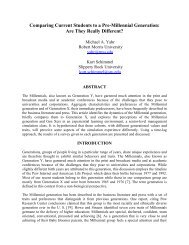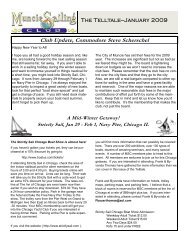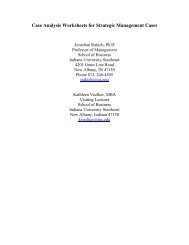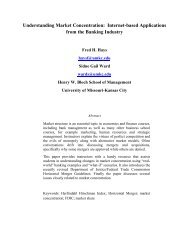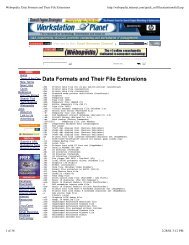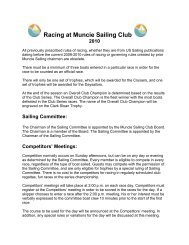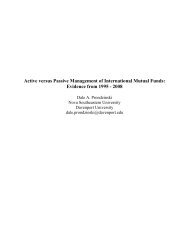Factors Hindering Export Development in Africa: Empirical Evidence ...
Factors Hindering Export Development in Africa: Empirical Evidence ...
Factors Hindering Export Development in Africa: Empirical Evidence ...
You also want an ePaper? Increase the reach of your titles
YUMPU automatically turns print PDFs into web optimized ePapers that Google loves.
CONCEPTUAL FRAMEWORKThe conceptual framework for this study is based on prior studies on export development. Thereare four basic factors that h<strong>in</strong>der export development [20]. The four factors <strong>in</strong>clude exportknowledge, <strong>in</strong>ternal resource constra<strong>in</strong>ts, procedural barriers and exogenous barriers [20]. First,‘export knowledge’ barriers refer to lack of <strong>in</strong>formation and knowledge about aspects related toexport activity. Lack of export knowledge has been established as an export barrier and mayconstitute an obstacle to <strong>in</strong>creased commitment to <strong>in</strong>ternational activity with<strong>in</strong> a company [1].<strong>Export</strong> knowledge covers areas such as plann<strong>in</strong>g and general tactical pr<strong>in</strong>ciples of export<strong>in</strong>gregardless of the target market <strong>in</strong> question.Second, ‘<strong>in</strong>ternal resource constra<strong>in</strong>ts’ has been described as the need for a firm to possess aseries of resources <strong>in</strong> order for it to be able to <strong>in</strong>itiate export activity. This type of barrier isrelevant, as it has been highlighted as one of the ma<strong>in</strong> reasons why many firms, particularlysmall or medium-sized ones, prefer to cl<strong>in</strong>g on to a domestically orientated strategy (4). Thefollow<strong>in</strong>g aspects have been identified as the most important <strong>in</strong>ternal resource barriers: lack off<strong>in</strong>ancial resources, and lack of personnel to devote time to export, and lack of productioncapacity [3; 4; 21].Third, are the procedural barriers, which have been described as an obstacles perta<strong>in</strong><strong>in</strong>g to theactivity itself and which could have their orig<strong>in</strong>s either <strong>in</strong> the firm’s domestic market or <strong>in</strong> theforeign markets [24]. Procedural barriers can be subdivided <strong>in</strong>to two types: (a) controllable,those which can be easily solved given the right experience (e.g. documentation); and (b) notcontrollable, requir<strong>in</strong>g case-by-case decisions, <strong>in</strong>dependent of the rout<strong>in</strong>e which has beenacquired through experience [20]. The follow<strong>in</strong>g aspects of export activity can be considered asprocedural barriers: red tape and documentation, non-tariff barriers, import tariffs, transportationand distribution difficulties <strong>in</strong> foreign markets. F<strong>in</strong>ally, exogenous barriers are described asobstacles that are externally imposed on the firms which are outside the control of the export<strong>in</strong>gcompany [20]. <strong>Factors</strong> such as the powerful competition faced <strong>in</strong> foreign markets, the risk ofvariation <strong>in</strong> exchange rates, political <strong>in</strong>stability <strong>in</strong> foreign and domestic markets [3; 11; 13; 14].LITERATURE REVIEW AND HYPOTHESESKnowledge BarriersIn their sem<strong>in</strong>al work, [24] identified four sources of export barriers that affect firms’ exportactivities. They <strong>in</strong>clude export knowledge, <strong>in</strong>ternal resource constra<strong>in</strong>ts, procedural barriers andexogenous variables. In the follow<strong>in</strong>g paragraphs we will comment on each of these exportbarriers <strong>in</strong>dividually. First, export knowledge barriers refer to lack of <strong>in</strong>formation relat<strong>in</strong>g toexport activity. In his pioneer work, [1] asserted that lack of knowledge about foreign marketsconstitutes a barrier to <strong>in</strong>creased commitment to <strong>in</strong>ternational activity with<strong>in</strong> a company. Inanother landmark study by [5] highlighted the dynamic nature of barriers to export<strong>in</strong>g. Theyfound that firms start<strong>in</strong>g export activity face difficulties <strong>in</strong> identify<strong>in</strong>g opportunities <strong>in</strong> exportmarkets. In a similar study conducted by [23], the follow<strong>in</strong>g were identified as knowledgebarriers, lack of awareness of export assistance, lack of awareness of benefits of export markets,lack of knowledge of best potential markets, lack of qualified staff, and overall lack ofknowledge of how to enter the export market [23, p.409].



